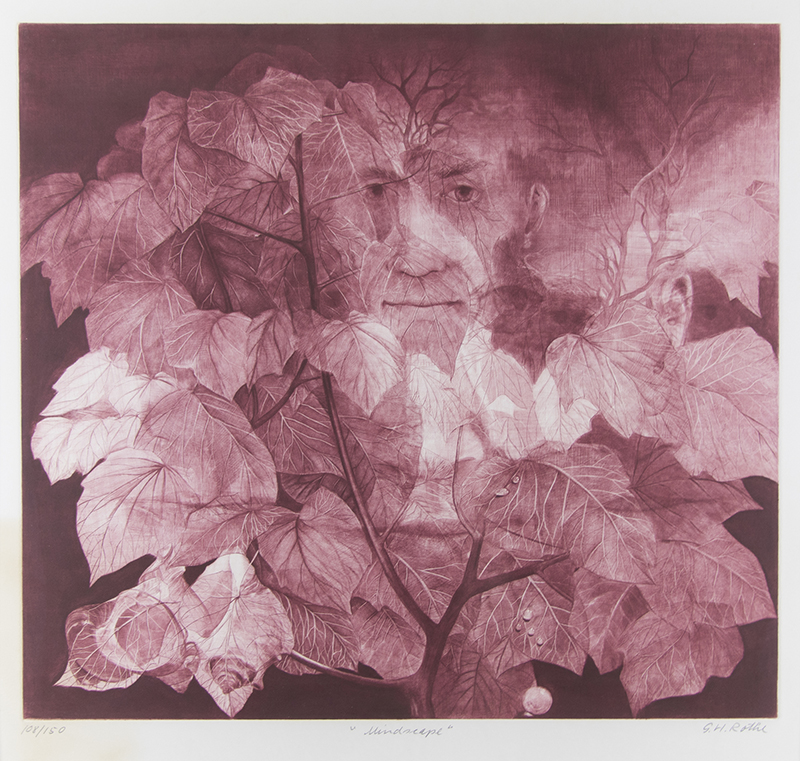Drawing with Light
Mezzotint Prints from the Rossof Collection
January 19–June 26, 2021
 The term mezzotint comes from Italian and literally means “half-tone.” It is the name
of a printmaking technique that uses tones rather than lines to depict forms and define
spaces. The mezzotint printmaking process starts with the artist roughening the surface
of a metal plate so that it will hold ink and print a completely black field when
the plate is run through a press. The artist then uses special tools to burnish selected
areas of the plate, reducing or removing the roughened surface so that the plate will
print a range of gray tones or white spaces in those areas. Through the burnishing
process, an artist can produce highly refined pictorial images with subtly modulated
tones similar to those found in oil paintings, watercolors and ink wash drawings.
The 20th-century American printmaker Robert Kipniss once succinctly described the
mezzotint process this way: “In mezzotint you draw with light. You start with velvety
black and gradually introduce degrees of illumination and, as your focus sharpens,
you slowly evolve shapes and space from darkness.”
The term mezzotint comes from Italian and literally means “half-tone.” It is the name
of a printmaking technique that uses tones rather than lines to depict forms and define
spaces. The mezzotint printmaking process starts with the artist roughening the surface
of a metal plate so that it will hold ink and print a completely black field when
the plate is run through a press. The artist then uses special tools to burnish selected
areas of the plate, reducing or removing the roughened surface so that the plate will
print a range of gray tones or white spaces in those areas. Through the burnishing
process, an artist can produce highly refined pictorial images with subtly modulated
tones similar to those found in oil paintings, watercolors and ink wash drawings.
The 20th-century American printmaker Robert Kipniss once succinctly described the
mezzotint process this way: “In mezzotint you draw with light. You start with velvety
black and gradually introduce degrees of illumination and, as your focus sharpens,
you slowly evolve shapes and space from darkness.”
 The rudimentary techniques of mezzotint printmaking were first developed by German
artist Ludwig von Siegen (1609–1680) in the early 1640s. Those techniques were further
refined in the 1650s and 60s by Anglo-German artist Prince Rupert of the Rhine (1619–1682)
and his Flemish pupil Wallerant Vaillant (1623–1677). Influenced by Prince Rupert
and Vaillant, London and Amsterdam emerged as the most important centers of mezzotint
printmaking in the late 17th and 18th centuries. Although some artists used the technique
to create original images, it was most commonly used to reproduce existing paintings
and drawings. The popularity of mezzotints declined during the 19th century in the
face of competition from other reproductive art techniques such as lithography and
photography. A small number of artists in Europe and America kept the mezzotint technique
alive through the early decades of the 20th century, and helped to lead a revival
of mezzotint printmaking after World War II. Today, mezzotint printmaking is practiced
by artists in numerous countries around the world who value the rich aesthetic effects
that can be achieved with this difficult, time-consuming process.
The rudimentary techniques of mezzotint printmaking were first developed by German
artist Ludwig von Siegen (1609–1680) in the early 1640s. Those techniques were further
refined in the 1650s and 60s by Anglo-German artist Prince Rupert of the Rhine (1619–1682)
and his Flemish pupil Wallerant Vaillant (1623–1677). Influenced by Prince Rupert
and Vaillant, London and Amsterdam emerged as the most important centers of mezzotint
printmaking in the late 17th and 18th centuries. Although some artists used the technique
to create original images, it was most commonly used to reproduce existing paintings
and drawings. The popularity of mezzotints declined during the 19th century in the
face of competition from other reproductive art techniques such as lithography and
photography. A small number of artists in Europe and America kept the mezzotint technique
alive through the early decades of the 20th century, and helped to lead a revival
of mezzotint printmaking after World War II. Today, mezzotint printmaking is practiced
by artists in numerous countries around the world who value the rich aesthetic effects
that can be achieved with this difficult, time-consuming process.
Drawing with Light offered a chronological survey of mezzotint printmaking from the 17th century to the present day. It intentionally included works by many different artists representing a broad range of subjects and styles. The Kruizenga Art Museum is extremely grateful to Arthur and Kristine Rossof of Douglas, Michigan who donated or lent the great majority of prints featured in the exhibition.
Top Image: Mindscape, Gatja Helgart Rothe (German, 1935–2007), 1977, Mezzotint, Gift of Arthur and Kristine Rossof, 2017.69.5
Bottom Image: Still Night, Frederick Mershimer (American, born 1958), 1989, Mezzotint, Gift of Arthur and Kristine Rossof, 2019.90.57
View Drawing with Light exhibition and additional related artworks in the KAM collection database
Download the Drawing with Light unofficial study guide (PDF)
Kruizenga Art Museum271 Columbia AvenueHolland, MI 49423
workP. 616.395.6400
kruizengamuseum@hope.edu